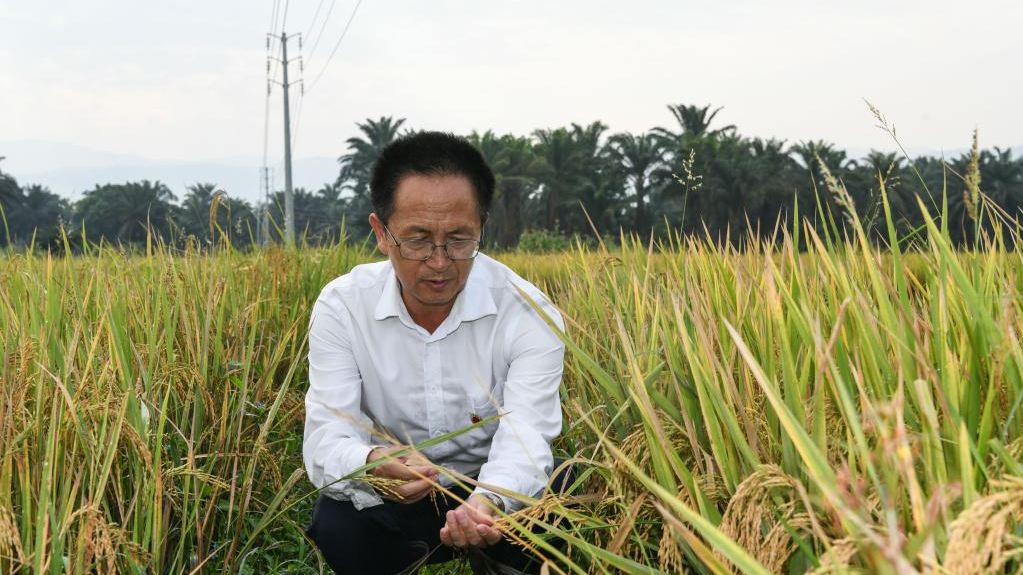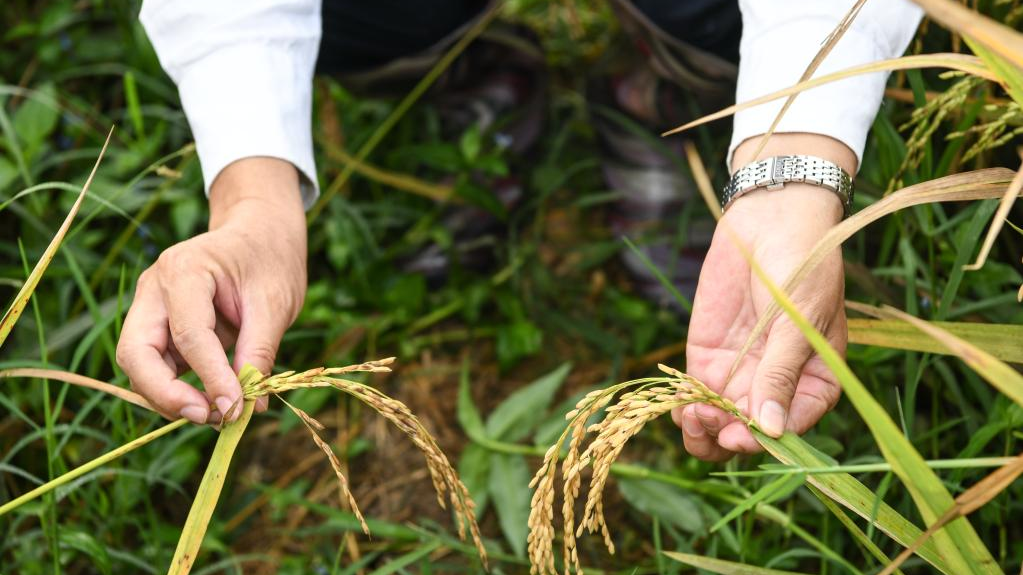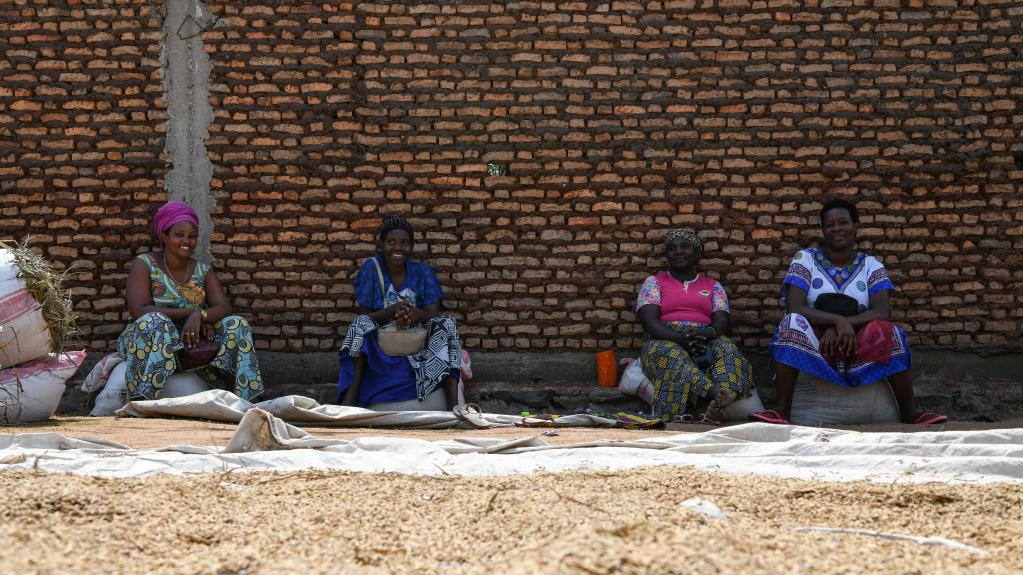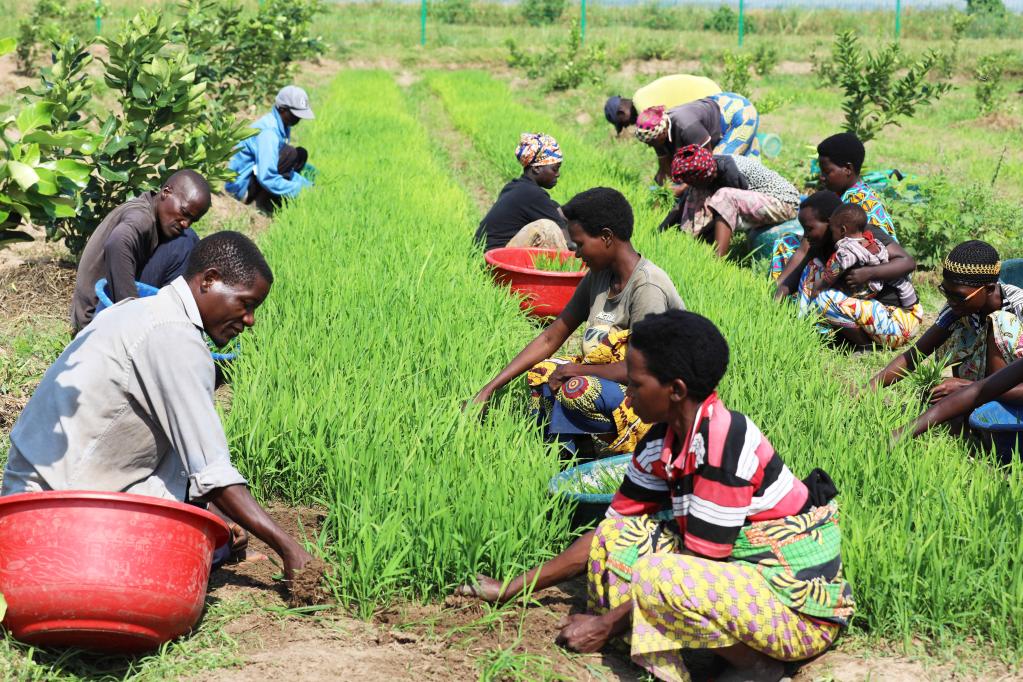
Yang Huade, a Chinese expert in rice farming, inspects rice production in the Commune of Gihanga in Burundi's northwestern Bubanza province, June 20, 2023. /Xinhua
Yang Huade, a Chinese expert in rice farming, inspects rice production in the Commune of Gihanga in Burundi's northwestern Bubanza province, June 20, 2023. /Xinhua
When Yang Huade first arrived in Burundi, he was struck by the severe food shortages in the country.
"At that time, the residents here were grappling with food scarcity, often having just one or two meals a day, mainly consisting of cassava and corn," said Yang, who had spent the majority of his career as an agricultural technician in his hometown of Weiyuan County in southwest China's Sichuan Province.
In 2015, at the age of 51, Yang led a team of Chinese agricultural experts to the East African country. They were the third group of senior agricultural experts sent by China. Over the past eight years, Burundi's rice yield has significantly increased, rising from an average of three tonnes per hectare to 10.
In May 2022, Yang received the award of good harvest "Cup of the Ambassador of China to Burundi 2022" from the Burundian President, for his exceptional contribution to the development of agriculture in the country.
As part of China's bilateral technical cooperation programs within the Forum on China-Africa Cooperation in 2009, China began to dispatch five groups of senior agricultural experts to Burundi to bolster the country's farming sector. These experts have been sharing their knowledge and experience to enhance production in response to the needs of the local population.
Address challenges in rice cultivation
Burundi has a population of over 12 million, but only roughly 1.3 million hectares of arable land. Though the country has favorable conditions for rice cultivation, like abundant water resources and ample sunlight, its agricultural productivity remains low.
"Weak infrastructure and outdated agricultural techniques made it hard for Burundi to achieve self-sufficiency in agricultural products," said Yang.
Agricultural cultivation primarily depends on garden hoes, with very limited access to other production tools. The presence of disease also poses a big challenge, in severe instances, the harvest is almost nonexistent, he added. "Due to the backward technology and unsatisfactory yields, rice cultivation isn't widespread in the region."
Apart from the technological limitations, the expert team found that the rice varieties being grown in this area were all conventional, which is not ideal for robust growth.
Having dedicated most of his career to scientific research on hybrid rice in China, Yang Huade is well-versed in the advantages of stable and high-yielding hybrid rice.

Yang Huade, a Chinese expert in rice farming, checks the hybrid rice (R) and local rice breed in the Commune of Gihanga, Bubanza Province, Burundi, June 20, 2023. /Xinhua
Yang Huade, a Chinese expert in rice farming, checks the hybrid rice (R) and local rice breed in the Commune of Gihanga, Bubanza Province, Burundi, June 20, 2023. /Xinhua
Half a century ago, hybrid rice was successfully developed and widely adopted in China, contributing to the country's ability to feed nearly one-fifth of the world's population while utilizing less than nine percent of the world's arable land.
Consequently, the experts reached a consensus and decided to introduce hybrid rice cultivation in Burundi. Since April 2016, the expert team has chosen seven domestic hybrid rice varieties for trial planting in Burundi. While there are established cultivation specifications domestically, these guidelines couldn't be directly applied here due to differences in climate conditions.
"In the initial phase, we noticed that the total growth period for our varieties in Sichuan exceeds 150 days, but in Burundi, it's around 120 days," said Yang.
"The shortened 30 days means the entire cultivation technology system needs to be adjusted," Yang explained. "The challenge was that we lacked prior experience in this context."
To address this, the expert team conducted extensive field research across all 15 rice-growing provinces in Burundi, identifying eight rice seed varieties suited to the local environment.
After a series of experiments, the highest yield was achieved with Y-liangyou 900 (YLY900), a new super hybrid rice widely adopted in China. The rice yielded 13.86 tonnes per hectare, five to six times higher than before.
At first, the local residents had modest expectations, but they soon realized that our rice varieties displayed superior overall growth and vitality compared to the local ones.
"This piqued their curiosity, and many farmers came to the field to observe," said Yang.
To further validate the potential of promoting hybrid rice in Burundi and detail the technical specifications, the team conducted three successive phases of trial planting.
"It created quite a stir among the local residents, who found it astonishing, almost like witnessing magic."

Farmers drying harvested rice in the Commune of Gihanga, Bubanza Province, Burundi, June 20, 2023. /Xinhua
Farmers drying harvested rice in the Commune of Gihanga, Bubanza Province, Burundi, June 20, 2023. /Xinhua
Making rice farming sustainable
In 2018, during the Forum on China-Africa Cooperation, China and Burundi signed a Memorandum of Understanding for cooperation on the Belt and Road Initiative. China said that agricultural cooperation could be a catalyst to bolster the Burundian economy, as agriculture is the country's economic backbone.
After that, the Chinese expert team established their base in the Commune of Gihanga in Bubanza province, located in northwestern Burundi. They initiated the pilot demonstration and promotion of hybrid rice.
In the same year, after completing the third phase of trial planting, Yang was eligible to return to his hometown as the employment term for the third batch of senior agricultural experts assisting Burundi came to an end.
However, Yang decided to remain, motivated by the prospect of the fourth phase of trial planting and its potential to enhance local income through increased rice yields. This may seem like a natural progression, but achieving it was no simple task.
Many challenges existed, with the primary one being the need for local farmers to accept and invest in hybrid rice, according to Yang. "Farmers here are very impoverished, lacking the necessary resources and funds."
To solve the financial problem, the expert team collaborated with local departments to establish a hybrid rice demonstration production investment fund.
Local farmers received essential supplies, including seeds, pesticides, fertilizers and herbicides.
The sole requirement was that, after the harvest, these farmers needed to pool the initial investment provided by the Chinese experts for the following season, Yang explained.

Farmers raising hybrid rice seedlings in the Commune of Gihanga, Bubanza Province, Burundi, October 29, 2022. /Xinhua
Farmers raising hybrid rice seedlings in the Commune of Gihanga, Bubanza Province, Burundi, October 29, 2022. /Xinhua
Beyond financial support, the expert team placed emphasis on providing technical training to farmers, who received training in each planting phase.
"Through multiple planting cycles, farmers can steadily enhance their rice cultivation skills and become accomplished farmers within two or three years," said Yang. "This is the best way to ignite their inner drive and enthusiasm instead of providing them with funds."
As China's cooperation with Burundi deepened, the number of hybrid rice demonstration villages gradually expanded. Presently there are 36, spanning across 14 provinces in the country.
Yang said that creating this many demonstration villages wasn't achievable solely through the effort of their expert team. They enlisted young individuals with high language proficiency and cultural knowledge for training and assistance in this endeavor.
In 2017, nearly 2.6 million Burundians, roughly 26 percent of the total population, faced acute food insecurity, according to the UN Office for the Coordination of Humanitarian Affairs. By 2022, that number had decreased to 1.4 million.
"If we can fully promote hybrid rice throughout the country, and if it can be extended to cover 100,000 hectares, this country's food problem will essentially be resolved. In terms of timing, this could potentially happen by 2029," Yang said.